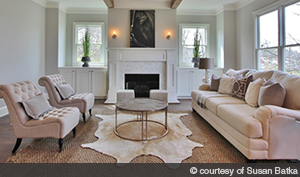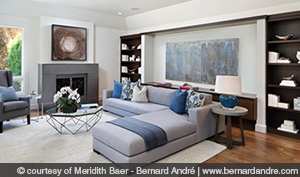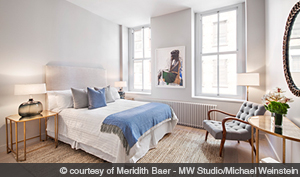While decluttering a listing before putting it on the market will help sellers keep their homes cleaner and get a head start on packing, this practice also helps the product that’s for sale shine through more clearly. “Staging isn’t about decorating, but putting a room and its architecture in the best light,” says Chicago-area designer and stager Paula Winter.
But stagers also caution against stripping too much away, which can make a space feel stark and uninviting. The happy medium is instead a modern, minimalist look that permits buyers to imagine how their furnishings may fit in spatially while exuding warmth from some carefully added accessories.
Staging, once mostly for vacant homes or high-priced listings, is now more widely used. Meridith Baer, who stages more than 140 properties a month through her eponymous California firm, says the practice can help increase the sales price and decrease the listing time for homes. The Real Estate Staging Association pegs the average time on the market for homes sold after staging at 21 days, an estimated 90 percent less time than unstaged properties.
Bear in mind that different generations have slightly different design tastes and tolerance for clutter or spareness, as do buyers in different geographic markets and price points. “Many in the greater Los Angeles area have been asking for a more minimal look, but in Orange County and Northern California, high-end properties still reflect a rich layering that shows a well-lived, well-traveled life,” Baer says. Here are five recommendations to strike the right balance.
1.
Set the stage. It’s called staging for a reason. The idea is to set the mood in the same way that a theatrical backdrop does. Think of how to use furnishings and accessories to tell a story about how a buyer may live there. You want the listing to look modern and gender-neutral to show a home’s bones, not to remind buyers of an antiseptic hospital or laboratory, says Winter. Certified stager Susan Batka of Aerie Interiors in suburban Atlanta suggests adding a few textured pillows, a rug, and maybe a large piece of modern, colorful artwork to give the space the necessary warmth so it looks alive but isn’t overwhelming or too personalized.
2.
Declutter. This is still the number one mantra for stagers. “The key to the desired Zen feel is to pick interesting but fewer decorative items and keep upholstered pieces clean and lean,” Baer says. She describes the goal as leaving “some breathing room. Not every wall space needs art and not every surface needs accessories.” It can be difficult to decide what to keep, but one good rule is to retain only the accessories that play up architectural features and strengths of the listing. Items that draw attention to built-in bookshelves or fireplace mantels are especially helpful. For example, Winter removes half the books on a shelf and arranges the remaining ones with turned-out spines or groups them by colors that work well with the room. She’ll winnow down collectibles on a shelf or coffee table to three key items rather than removing everything.
3.
Heed the size and shape of the room. You can use staging to highlight a room’s distinct features. If it has volume due to high ceilings, Baer will use a few larger-scaled furnishings. If it’s long and narrow, she generally fashions two seating groups, turning a rectangle into two squares. That way buyers can imagine a comfortable space where visitors can sit and converse intimately.
4.
Retain functionality within today’s style guidelines. Because space is highly valued, making the best use of all square footage remains a priority. Show this in listings by following the principles of cozy minimalism throughout a home. For example, in a master bedroom where buyers are looking to gain a sleep sanctuary, whittle down the furnishings to only the essential items of a comfortable bed, nightstands, and good lighting. The cozy factor can come in the form of blankets, pillows, a soft rug underfoot, and a soothing palette, says Batka. To outfit a spare room or a large landing, you might stage a workspace with a clean, modern desk and comfy upholstered chair.
5. Remember inexpensive tweaks. Good staging isn’t about grand gestures, large furnishings, or scads of accessories. Minor fixes can help what’s already there stand out without cluttering the space. Replace fixtures with bulbs of the same wattage and color, and hang clothing on similar hangers for a more uniform feel, says Jennifer Ames, a salesperson with Coldwell Banker Residential Brokerage in Chicago. “It gives buyers a good feeling as they walk through, that the sellers have cleaned and organized their homes,” she says. But in keeping with the cozy factor, avoid overwrought perfection. “Make anything you do look authentic, rather than contrived like putting out place settings at a table,” says Helen Bartlett, a RESA certified stager with Refined Interior Staging Solutions in Fairway, Kan. “Nobody lives that way.”








